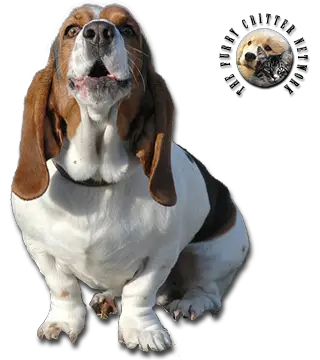Breed Standard
Head: Large, massive. Domed skull. Prominent occipital peak. Moderate stop. Bridge of nose slightly longer than skull. Cleanly cut muzzle. Strong jaws. Skin loose enough to form wrinkles. Flews cover most of lower lip.
Ears: Set on low, very long, longer than tip of muzzle when outstretched. Very supple, thin, narrow, and well-curled.
Eyes: Diamond-shaped. Dark to medium-brown in variety with light-colored coat. Conjunctiva of lower eyelid showing.
Body: Long and deep. Muscular neck with dewlap. Prominent sternum. Broad chest. Well-rounded ribs. Very muscular, well-sprung hindquarters. Fairly broad back.
Tail: Fairly long, thick at the base and tapering toward the tip. In action, carried raised, curved loosely in saber fashion.
Hair: Short, smooth, dense, but not too fine.
Coat: Generally tricolor (black, tan, and white); bicolor (lemon and white), but all hound colors are allowed.
Size: 33 to 38 cm (13-15 in).
Weight: 25-30 kg (33-44 lb).
History
English breeders crossed French bassets (the Artesian Norman Basset, the Artois Basset, and the Ardennes Basset) to arrive at the Basset Hound. The breed was shown for the first time in Paris in 1863 and in England in 1875, where it was developed. A Basset Hound club was founded in England in 1883, and the first standard was published in 1887. Basset Hounds were brought to the United States as early as 1883 and were very popular. In 1967, a Basset Hound club was founded in France to establish the breed.
Behavior
The tenacious Basset Hound hunts with his nose, works instinctively in packs, has a deep, melodious voice, and is not afraid of brambles. He has great endurance and is placid, never aggressive-his strong will and stubbornness are legendary. He is a skilled pack hound, trailing small and medium-sized game (including rabbit, hare, wild boar, and deer). Affectionate and gentle, he is a prized family friend. He needs firm training.
This athlete needs space and lots of exercise. He does not tolerate solitude or heat very well. He requires regular brushing and attention to the ears and eyes.
Function
Hunting Dog, Companion Dog.
Health
Do not overfeed these dogs because extra weight places too great a load on the legs and spine. A problem area is possible lameness and eventual paralysis because of short legs and a heavy, long body. As they are prone to bloat, it is also wise to feed them two or three small meals a day instead of one large meal. If they do eat a large meal keep an eye on them for several hours for any signs of bloat.






